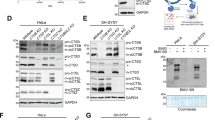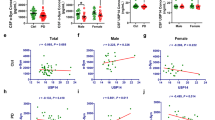Abstract
Mucopolysaccharidosis type I (MPS I) is a lysosomal storage disorder characterized by diminished degradation of the glycosaminoglycans (GAGs) heparan sulfate and dermatan sulfate, which results in the accumulation of these GAGs and subsequent cellular dysfunction. Patients present with a variety of symptoms, including severe skeletal disease. Genistein has been shown previously to inhibit GAG synthesis in MPS fibroblasts, presumably through inhibition of tyrosine kinase activity of the epidermal growth factor receptor (EGFR). To determine the potentials of genistein for the treatment of skeletal disease, MPS I fibroblasts were induced into chondrocytes and osteoblasts and treated with genistein. Surprisingly, whereas tyrosine phosphorylation levels (as a measure for tyrosine kinase inhibition) were decreased in all treated cell lines, there was a 1.3 and 1.6 fold increase in GAG levels in MPS I chondrocytes and fibroblast, respectively (p < 0.05). Sulfate incorporation in treated MPS I fibroblasts was 2.6 fold increased (p < 0.05), indicating increased GAG synthesis despite tyrosine kinase inhibition. This suggests that GAG synthesis is not exclusively regulated through the tyrosine kinase activity of the EGFR. We hypothesize that the differences in outcomes between studies on the effect of genistein in MPS are caused by the different effects of genistein on different growth factor signaling pathways, which regulate GAG synthesis. More studies are needed to elucidate the precise signaling pathways which are affected by genistein and alter GAG metabolism in order to evaluate the therapeutic potential of genistein for MPS patients.




Similar content being viewed by others
References
Akiyama T, Ishida J, Nakagawa S et al (1987) Genistein, a specific inhibitor of tyrosine-specific protein kinases. J Biol Chem 262:5592–5595
Aldenhoven M, Boelens JJ, de Koning TJ (2008) The clinical outcome of Hurler syndrome after stem cell transplantation. Biol Blood Marrow Transplant 14:485–498
Arfi A, Richard M, Gandolphe C, Scherman D (2010) Storage correction in cells of patients suffering from mucopolysaccharidoses types IIIA and VII after treatment with genistein and other isoflavones. J Inherit Metab Dis 33:61–67
Baldo G, Mayer FQ, Martinelli BZ et al (2013) Enzyme replacement therapy started at birth improves outcome in difficult-to-treat organs in mucopolysaccharidosis I mice. Mol Genet Metab 109:33–40
Blunk T, Sieminski AL, Gooch KJ et al (2002) Differential effects of growth factors on tissue-engineered cartilage. Tissue Eng 8:73–84
Blunk T, Sieminski AL, Appel B et al (2003) Bone morphogenetic protein 9: a potent modulator of cartilage development in vitro. Growth Factors 21:71–77
Coldham NG, Sauer MJ (2000) Pharmacokinetics of [(14)C]Genistein in the rat: gender-related differences, potential mechanisms of biological action, and implications for human health. Toxicol Appl Pharmacol 164:206–215
de Ruijter J, Valstar MJ, Narajczyk M et al (2012) Genistein in Sanfilippo disease: a randomized controlled crossover trial. Ann Neurol 71:110–120
Delgadillo V, O’Callaghan MM, Artuch R, Montero R, Pineda M (2011) Genistein supplementation in patients affected by Sanfilippo disease. J Inherit Metab Dis 34:1039–1044
Ferdinandusse S, Denis S, Dacremont G, Wanders RJ (2009) Toxicity of peroxisomal C27-bile acid intermediates. Mol Genet Metab 96:121–128
Gooch KJ, Blunk T, Courter DL, Sieminski AL, Vunjak-Novakovic G, Freed LE (2002) Bone morphogenetic proteins-2, -12, and -13 modulate in vitro development of engineered cartilage. Tissue Eng 8:591–601
Hiraki Y, Inoue H, Hirai R, Kato Y, Suzuki F (1988) Effect of transforming growth factor beta on cell proliferation and glycosaminoglycan synthesis by rabbit growth-plate chondrocytes in culture. Biochim Biophys Acta 969:91–99
Hwang KA, Park MA, Kang NH et al (2013) Anticancer effect of genistein on BG-1 ovarian cancer growth induced by 17 beta-estradiol or bisphenol A via the suppression of the crosstalk between estrogen receptor alpha and insulin-like growth factor-1 receptor signaling pathways. Toxicol Appl Pharmacol 272:637–646
Jakobkiewicz-Banecka J, Piotrowska E, Narajczyk M, Baranska S, Wegrzyn G (2009) Genistein-mediated inhibition of glycosaminoglycan synthesis, which corrects storage in cells of patients suffering from mucopolysaccharidoses, acts by influencing an epidermal growth factor-dependent pathway. J Biomed Sci 16:26
Junker JP, Sommar P, Skog M, Johnson H, Kratz G (2010) Adipogenic, chondrogenic and osteogenic differentiation of clonally derived human dermal fibroblasts. Cells Tissues Organs 191:105–118
Kim H, Xu J, Su Y et al (2001) Actions of the soy phytoestrogen genistein in models of human chronic disease: potential involvement of transforming growth factor beta. Biochem Soc Trans 29:216–222
Kim KH, Dodsworth C, Paras A, Burton BK (2013) High dose genistein aglycone therapy is safe in patients with mucopolysaccharidoses involving the central nervous system. Mol Genet Metab 109:382–385
Kingma SD, Langereis EJ, De Klerk CM et al (2013) An algorithm to predict phenotypic severity in mucopolysaccharidosis type I in the first month of life. Orphanet J Rare Dis 8:99
Kloska A, Jakobkiewicz-Banecka J, Narajczyk M, Banecka-Majkutewicz Z, Wegrzyn G (2011) Effects of flavonoids on glycosaminoglycan synthesis: implications for substrate reduction therapy in Sanfilippo disease and other mucopolysaccharidoses. Metab Brain Dis 26:1–8
Kloska A, Narajczyk M, Jakobkiewicz-Banecka J et al (2012) Synthetic genistein derivatives as modulators of glycosaminoglycan storage. J Transl Med 10:153
Koc ON, Day J, Nieder M, Gerson SL, Lazarus HM, Krivit W (2002) Allogeneic mesenchymal stem cell infusion for treatment of metachromatic leukodystrophy (MLD) and Hurler syndrome (MPS-IH). Bone Marrow Transplant 30:215–222
Lowry OH, Rosebrough NJ, Farr AL, Randall RJ (1951) Protein measurement with the Folin phenol reagent. J Biol Chem 193:265–275
Mackie EJ, Tatarczuch L, Mirams M (2011) The skeleton: a multi-functional complex organ: the growth plate chondrocyte and endochondral ossification. J Endocrinol 211:109–121
Malinova V, Wegrzyn G, Narajczyk M (2012) The use of elevated doses of genistein-rich soy extract in the gene expression-targeted isoflavone therapy for Sanfilippo disease patients. JIMD Rep 5:21–25
Malinowska M, Wilkinson FL, Langford-Smith KJ et al (2010) Genistein improves neuropathology and corrects behaviour in a mouse model of neurodegenerative metabolic disease. PLoS One 5:e14192
Muenzer J (2011) Overview of the mucopolysaccharidoses. Rheumatology (Oxford) 50(Suppl 5):v4–12
Oussoren E, Brands MM, Ruijter GJ, der Ploeg AT, Reuser AJ (2011) Bone, joint and tooth development in mucopolysaccharidoses: relevance to therapeutic options. Biochim Biophys Acta 1812:1542–1556
Piotrowska E, Jakobkiewicz-Banecka J, Baranska S et al (2006) Genistein-mediated inhibition of glycosaminoglycan synthesis as a basis for gene expression-targeted isoflavone therapy for mucopolysaccharidoses. Eur J Hum Genet 14:846–852
Piotrowska E, Jakobkiewicz-Banecka J, Maryniak A et al (2011) Two-year follow-up of Sanfilippo Disease patients treated with a genistein-rich isoflavone extract: assessment of effects on cognitive functions and general status of patients. Med Sci Monit 17:CR196–CR202
Ramakers C, Ruijter JM, Deprez RH, Moorman AF (2003) Assumption-free analysis of quantitative real-time polymerase chain reaction (PCR) data. Neurosci Lett 339:62–66
Sifuentes M, Doroshow R, Hoft R et al (2007) A follow-up study of MPS I patients treated with laronidase enzyme replacement therapy for 6 years. Mol Genet Metab 90:171–180
Simonaro CM, D’Angelo M, He X et al (2008) Mechanism of glycosaminoglycan-mediated bone and joint disease: implications for the mucopolysaccharidoses and other connective tissue diseases. Am J Pathol 172:112–122
Tirone E, D’Alessandris C, Hascall VC, Siracusa G, Salustri A (1997) Hyaluronan synthesis by mouse cumulus cells is regulated by interactions between follicle-stimulating hormone (or epidermal growth factor) and a soluble oocyte factor (or transforming growth factor beta1). J Biol Chem 272:4787–4794
van der Linden MH, Kruyt MC, Sakkers RJ, de Koning TJ, Oner FC, Castelein RM (2011) Orthopaedic management of Hurler’s disease after hematopoietic stem cell transplantation: a systematic review. J Inherit Metab Dis 34:657–669
Weisstein JS, Delgado E, Steinbach LS, Hart K, Packman S (2004) Musculoskeletal manifestations of Hurler syndrome: long-term follow-up after bone marrow transplantation. J Pediatr Orthop 24:97–101
White KK (2011) Orthopaedic aspects of mucopolysaccharidoses. Rheumatology (Oxford) 50(Suppl 5):v26–v33
Yuan WJ, Jia FY, Meng JZ (2009) Effects of genistein on secretion of extracellular matrix components and transforming growth factor beta in high-glucose-cultured rat mesangial cells. J Artif Organs 12:242–246
Acknowledgments
We thank Rene Leen, Vincent Everts, Henk van Lenthe, Wim Kulik and Ronald Wanders for technical assistance and helpful discussions. We thank Gregorz Węgrzyn for kindly providing the protocol for sulfate incorporation and helpful discussions and Axcentua for providing genistein. This work was funded by the WE foundation and the foundation ‘Steun Emma Kinderziekenhuis AMC’.
Compliance with ethics guidelines
ᅟ
Conflict of interest
Sandra Kingma, Tom Wagemans, Lodewijk IJlst, Frits Wijburg and Naomi van Vlies declare that they have no conflicts of interest.
Informed consent
Informed consent for the use of fibroblast cell lines was obtained from all patients or parents of the patients. Apart from experiments using these cell lines, this article does not contain any studies with human or animal subjects performed by the any of the authors.
Author information
Authors and Affiliations
Corresponding author
Additional information
Communicated by: Alberto B. Burlina
Rights and permissions
About this article
Cite this article
Kingma, S.D.K., Wagemans, T., IJlst, L. et al. Genistein increases glycosaminoglycan levels in mucopolysaccharidosis type I cell models. J Inherit Metab Dis 37, 813–821 (2014). https://doi.org/10.1007/s10545-014-9703-x
Received:
Revised:
Accepted:
Published:
Issue Date:
DOI: https://doi.org/10.1007/s10545-014-9703-x




